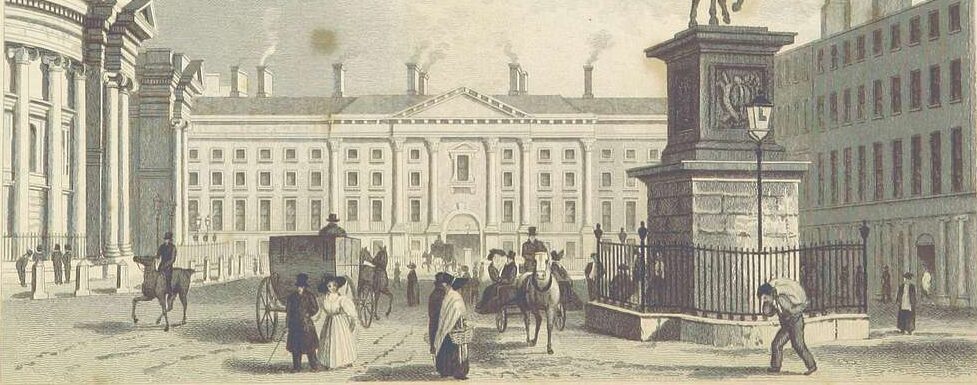 This is the fourth post (in a series of seven; see also parts I, II, III, V, VI and VII) discussing Samsoondar v Capital Insurance Company Ltd (Trinidad and Tobago) [2020] UKPC 33 (14 December 2020) (Samsoondar) and Surrey County Council v NHS Lincolnshire Clinical Commissioning Group [2020] EWHC 3550 (QB) (21 December 2020) (Surrey). In my first post, I introduced the cases and issues. A claim to restitution for unjust enrichment failed in the first but succeeded in the second. In my second post, I examined whether the defendants were enriched at the expense of the plaintiffs.
This is the fourth post (in a series of seven; see also parts I, II, III, V, VI and VII) discussing Samsoondar v Capital Insurance Company Ltd (Trinidad and Tobago) [2020] UKPC 33 (14 December 2020) (Samsoondar) and Surrey County Council v NHS Lincolnshire Clinical Commissioning Group [2020] EWHC 3550 (QB) (21 December 2020) (Surrey). In my first post, I introduced the cases and issues. A claim to restitution for unjust enrichment failed in the first but succeeded in the second. In my second post, I examined whether the defendants were enriched at the expense of the plaintiffs.
In my previous post, I considered whether compulsory discharge of the debt of another could have provided a cause of action in Samsoondar and Surrey, concluding that it could not in the former but that it could in the latter; and I considered whether Surrey could rely upon a policy-motivated cause of action, consisting in the unlawful obtaining or conferral of a benefit by a public authority. With some difficulty, Thornton J held that Surrey could indeed rely upon it. In this post, I want to consider another – simpler, more straightforward – cause of action that may have been available on the facts of both cases, and that could, in particular, have alleviated the difficulties encountered by Thornton J in Surrey.
Her contortions may not have been necessary, for at least two reasons. First, as we have already seen, Surrey could have relied upon cases like Moule v Garrett (1872) LR 7 Exch 101 and Brooks Wharf v Goodman [1937] 1 KB 543 to seek restitution for unjust enrichment from Lincs. Second, it was common ground in the case that Lincs “erred in law when it declined Surrey’s invitation to assess JD’s eligibility for NHS care” (at [68]). If Surrey shared that mistake, or if Lincs induced that mistake in Surrey, then they could have argued that their mistaken discharge of Lincs’s obligation unjustly enriched Lincs their expense.
In Samsoondar, Capital had sought to rely on mistake of law as an alternative to legal compulsion. However, the matter had not been pleaded, when it could have been; and no relevant evidence had been adduced; so Lord Burrows held (at [24]) that the mistake claim also failed. Nevertheless, he went on to hold (at [25], obiter) that there is no good reason in principle “why reliance on mistake rather than legal compulsion should mean that no restitution is available in respect of the discharge of another’s liability”.
The traditional action arising out the compulsory discharge of the debt of another is composed of an unjust factor (compulsion) and an enrichment (the discharge of the other’s debt). If that separation is made, then any unjust factor may in prinicple be combined with that enrichment to generate an action in restitution. For example, if a plaintiff mistakenly discharges the debt of another, the mistake would supply the unjust factor, the discharge would again constitute the enrichment, and the plaintiff can have restitution. County of Carleton v City of Ottawa [1965] SCR 663, 1965 CanLII 15 (SCC) (25 May 1965) – to which Thornton J briefly referred en passant (at [65], [117]-[118]) – may provide an example. Responsibility for an indigent had moved from Carleton to Ottawa, but Carleton continued to pay for her care. Relying on Moule v Garrett, Brooks Wharf v Goodman, and Deglman v Guaranty Trust Company of Canada and Constantineau [1954] SCR 725, 734, 1954 CanLII 2 (SCC) (Cartwright J; Estey, Locke and Fauteux JJ concucrring), Hall J in Carleton held that it would be “against conscience” for Ottawa to “escape responsbility” ([1965] SCR 663, 669 (Hall J; Cartwright, Judson, Ritchie and Spence JJ concuring)). The reason why it was against conscience, that is, the reason why Ottawa’s enrichment was unjust, was because it had been caused by Carleton’s mistake.
 Another excellent example is supplied by the old Irish case of Rochfort v Earl of Belvidere (1770) Wall L 45 (pdf), featuring the notorious Robert Rochfort, first Earl of Belvidere (pictured top left). [I am grateful to Daniel Donnelly for bringing this case to my attention]. In the case itself (at 50), Lord Chancellor Lifford (pictured right) cited cited Moses v Macferlan (1760) 2 Burr 1005, 97 ER 976, [1760] EngR 713 (19 May 1760) (pdf) with approval. The real and personal estate of the deceased had devolved independently. The successor to the real estate, mistakenly believing that he had a liability to do so, had paid off a portion of a debt which had attached to the personal estate; and Lord Lifford LC held that he was entitled to recover from the successor to the personal estate the amount so paid. (It is reported that the House of Lords affirmed, without judgment; see Earl of Belvedere v Rochfort (1772) 5 Bro PC 299; 2 ER 691, [1772] EngR 55 (8 May 1772) (pdf)). As Budd J put it in the High Court in the Bricklayers’ Hall case, it “would seem from the report [in Rochfort in the Irish Court of Chancery] that Moses v Macferlan was employed [by Lord Lifford LC] to justify restitution in circumstances where the plaintiff had paid off the debt of the personal estate of the [deceased]. … This would appear to be an example of a case in which the plaintiff had himself conferred the benefit on the defendant through mistake and where to allow the defendant to retain such a benefit would result in his being unjustly enriched at the plaintiff’s expense” (High Court, unreported, 6 March 1996, at pp20-21 of the transcript; this matter did not arise on appeal before Keane J at [1996] 2 IR 468, [1996] 2 ILRM 547 (24 July 1996) (doc | pdf | html); but Rochfort was referred to with approval by Baker J in Bank of Ireland Mortgage Bank v Murray [2019] IEHC 234 (12 April 2019) [157]).
Another excellent example is supplied by the old Irish case of Rochfort v Earl of Belvidere (1770) Wall L 45 (pdf), featuring the notorious Robert Rochfort, first Earl of Belvidere (pictured top left). [I am grateful to Daniel Donnelly for bringing this case to my attention]. In the case itself (at 50), Lord Chancellor Lifford (pictured right) cited cited Moses v Macferlan (1760) 2 Burr 1005, 97 ER 976, [1760] EngR 713 (19 May 1760) (pdf) with approval. The real and personal estate of the deceased had devolved independently. The successor to the real estate, mistakenly believing that he had a liability to do so, had paid off a portion of a debt which had attached to the personal estate; and Lord Lifford LC held that he was entitled to recover from the successor to the personal estate the amount so paid. (It is reported that the House of Lords affirmed, without judgment; see Earl of Belvedere v Rochfort (1772) 5 Bro PC 299; 2 ER 691, [1772] EngR 55 (8 May 1772) (pdf)). As Budd J put it in the High Court in the Bricklayers’ Hall case, it “would seem from the report [in Rochfort in the Irish Court of Chancery] that Moses v Macferlan was employed [by Lord Lifford LC] to justify restitution in circumstances where the plaintiff had paid off the debt of the personal estate of the [deceased]. … This would appear to be an example of a case in which the plaintiff had himself conferred the benefit on the defendant through mistake and where to allow the defendant to retain such a benefit would result in his being unjustly enriched at the plaintiff’s expense” (High Court, unreported, 6 March 1996, at pp20-21 of the transcript; this matter did not arise on appeal before Keane J at [1996] 2 IR 468, [1996] 2 ILRM 547 (24 July 1996) (doc | pdf | html); but Rochfort was referred to with approval by Baker J in Bank of Ireland Mortgage Bank v Murray [2019] IEHC 234 (12 April 2019) [157]).
In both Samsoondar and Surrey, the relevant mistakes were as to the application of existing statutes, and thus amounted to mistakes of law. But this is no longer a bar to a claim in restitution for unjust enrichment: “that a causative mistake of law, as well as a mistake of fact, counts as an unjust factor was laid down in Kleinwort Benson Ltd v Lincoln City Council [1999] 2 AC 349, [1998] UKHL 38 (29 October 1998)” (Samsoondar [23] (Lord Burrows); see also Test Claimants in the Franked Investment Income Group Litigation v Revenue and Customs [2020] UKSC 47 (20 November 2020) [143]-[146], [243] (Lord Reed and Lord Hodge, in a joint judgment; Lords Lloyd-Jones and Hamblen concurring)). Kleinwort Benson has been followed in Northern Ireland (Mallusk Cold Storage Ltd v Department of Finance and Personnel [2003] NIQB 58 (29 August 2003) (Coghlin J), affirmed on this point and reversed on a limitation point [2006] NICA 50 (12 December 2006); see also McAteer v Lismore [2015] NICh 3 (16 January 2015) [28] (Deeny J)). The mistake of law bar has also been abrogated as a matter of Irish law; for example, in the Bricklayers’ Hall case, Keane J gave “mistake of fact or law” as instances of categories which justify describing an enrichment as unjust ([1996] 2 IR 468, 483; [1996] 2 ILRM 547, 558, (24 July 1996) [40] (doc | pdf | html) (emphasis added); see also Ringsend Property Ltd v Donatex Ltd [2009] IEHC 568 (18 December 2009) (Kelly J) (referring to Kleinwort Benson); Vanguard Auto Finance Ltd v Browne [2014] IEHC 465 (14 October 2014) [73] (Barton J) (same); see, generally, Erik Gannon “The Rise and Fall of the Mistake of Law Rule” (2000) 3 Trinity College Law Review 73; Keith Spencer “Restitution of Monies Paid Pursuant to Mistake of Law” (2004) 12 Irish Student Law Review 153; Niamh Cleary “Restitution for Mistake of Law in Ireland” (2016) LV Irish Jurist (ns) 25).
So, the question in Samsoondar and Surrey would be whether Capital and Surrey had made their payments to their respective third parties in the mistaken belief that they were due. If so, then Occam’s Razor would suggest that the complicated policy-motivated cause of action relied on in Surrey should fall away, whilst Birks’s Augmentation would suggest that the simpler alternative based upon mistake should come to the fore in both Samsoondar and Surrey. This is certainly plausible on the facts of both cases, and gives rise to further questions of voluntariness and assumption of risk that I will consider in my next two posts (see parts V and VI). In particular, in my next post, I want to consider the effect of voluntariness in the discharge cases.

I say in the above post that a claim based on mistake is plausible in both Samsoondar and Surrey. But, in a recent note on Samsoondar, Steve Hedley has called that conclusion into question (see Steve Hedley “Restitution and Car Crashes. A Simple Case of Mistake” (2021) 80(1) Cambridge Law Journal 36 (sub req’d)):
My discussion of County of Carleton v City of Ottawa [1965] SCR 663, 1965 CanLII 15 (SCC) (25 May 1965) and Rochfort v Earl of Belvidere (1770) Wall L 45 in the post above is directed to establishing the cause of action in the three-party case which Steve regards as problematic. He also discusses whether Capital should properly be regarded as having been mistaken at all, or whether they should be regarded as having taken the risk that payment was not in fact due, and I address that issue in a comment to a subsequent post.
I have just re-encountered S R Scott “Mistaken Payment of Another’s Debt – Is there an equitable solution?” [1993] NZ Recent Law Review 232 (SSRN), discussing the decision of Holland J in Westpac Banking Corporation v Raw [1992] 1 NZLR 338. First, my apologies to Struan for having forgotten this piece when I was putting the above post together. Second, I was going to discuss it in this note, but the analysis became too long, so I am moving it to a post. Watch this space.